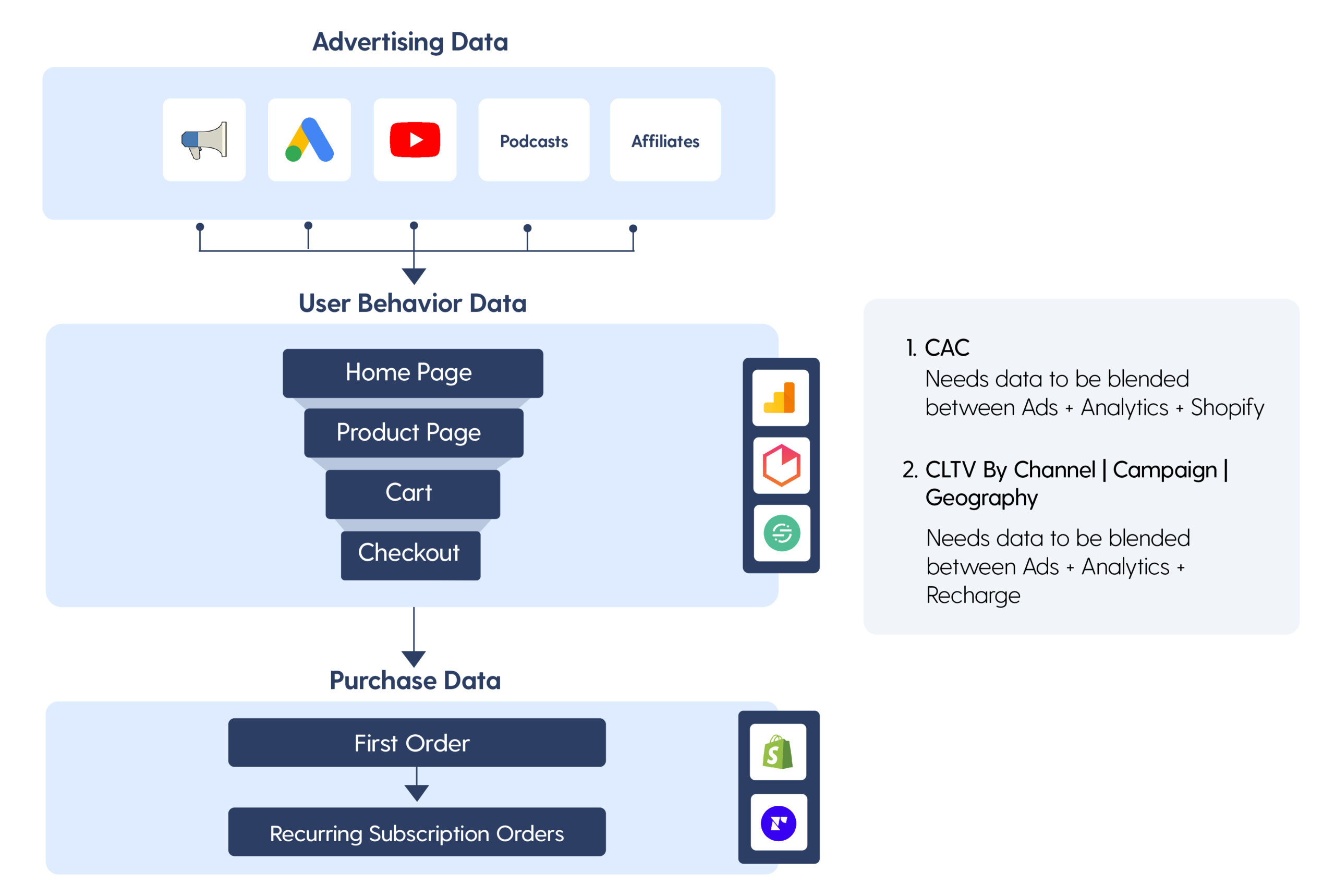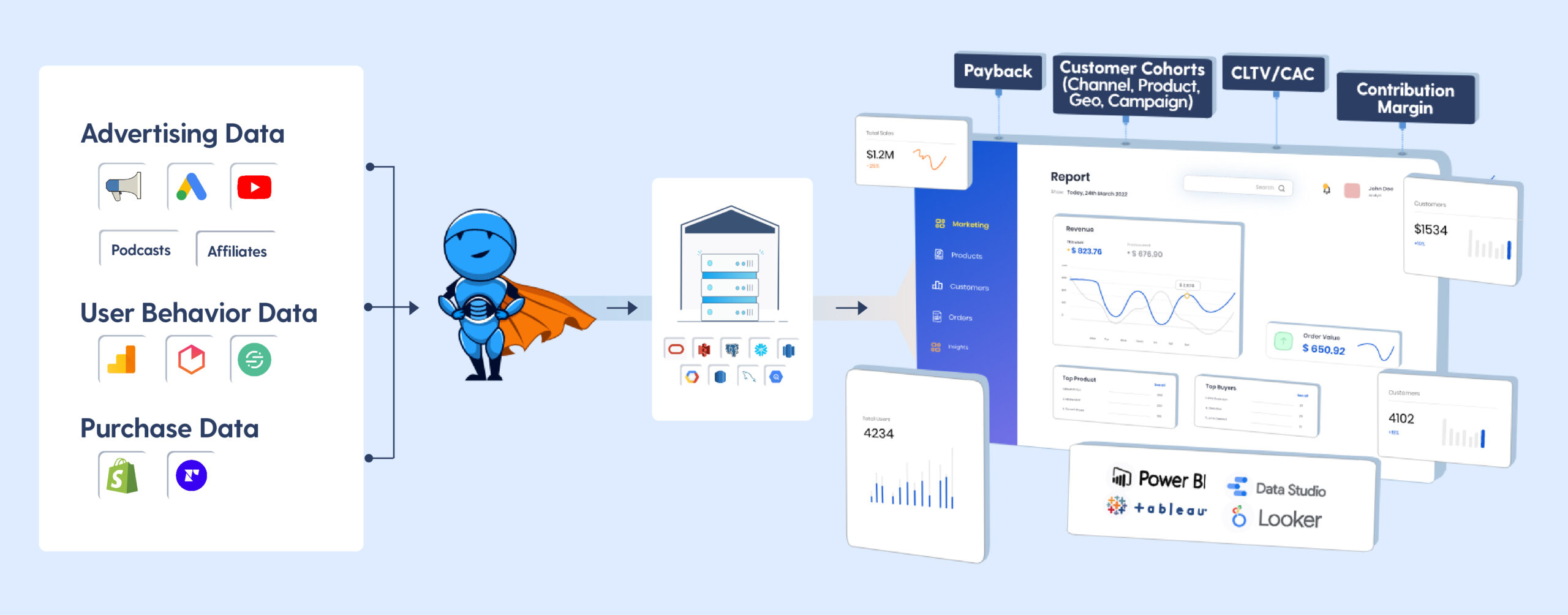CFOs hold a key role in formulating and impacting the organization’s growth agenda. CFOs require visibility into data reports across Sales, Marketing, Inventory, and Operations to plan budgets accordingly.
In uncertain times, with a looming recession, marketing expenses and ROI attribution have become a critical problem area, especially with the recent iOS 14updates. Focus has shifted from driving growth at unreasonable costs to driving profitability by increasing customer lifetime value.
In a survey by EY, 59% of the polled CFOs said that monitoring marketing ROI and gaining insights from customer first-party data is a key priority for them.
Understanding True Profitability
To elaborate on this multi-layered concept, an eCommerce organization with a subscription model or high repeat purchase behavior with a revenue range of $5 Million – $50 Million is an ideal fit.
Thriving brands such as Athletic Greens and Bare Performance Nutrition closely monitor their profitable customer cohorts.
Breaking this down further, successful CFOs have the following data points at their fingertips:
- Profitable customers
- By Channel
- By Product
- By Geographies
- OTP (one-time purchase) vs. Subscription
- Accurate Customer Acquisition Cost (CAC)
- Customer Lifetime Value (CLTV)
- Payback (CAC – Contribution Margin) on investments
- Multi-Touch Attribution Data
Trailblazing CFOs factor in CLTV/CAC, Retention Rates by advertising investments into P&L Modelling and leveraging daily reports of overall and sales channel level P&L to always stay ahead of the curve. From an investors/board standpoint also, most conversations are backed up by CLTV vs. CAC and profitability analysis.
However, only 5% of CFOs fall into this category. Most CFOs feel that they lack the proper visibility into these marketing metrics from a financial planning standpoint. It might be a mutual problem shared with the CMO as marketing budget discussions can be significantly streamlined if profitable cohorts, cost of acquiring customers by channel, AOV data, churn and retention rates, lifetime value, etc. are available. Relying on ROAS (Return on Ad Spend) alone does not give insights into how truly profitable those cohorts are or whether the campaigns are efficient or not in the medium to long term.
For example: If Payback (Customer Acquisition Cost – Contribution Margin) happens in 4 months, then CMO and CFO can align on advertising expenditure as it is backed by data that all the investment will be recovered in the time span of 4 months and its profit from there on.
Key Data Challenges
Having visibility into marketing spends, user behavior data, and purchase data is the desired state but let us understand what stops CFOs and organizations from achieving this.

Going deeper into the data silos, the marketing spends (FB Ads, Google Ads, YouTube, Podcasts, Affiliates) usually sit in individual tools or manual excel sheets. While the user behavior data (website home page, product pages, cart, and checkout) is siloed in Google Analytics, Segment, or Heap. Similarly, the purchase data (first order, recurring subscription orders) are siloed in Shopify, Recharge Payments, etc.
To calculate the Customer Acquisition Cost, data from Ads, Analytics, and Shopify must be blended. In the case of Lifetime Value, getting the overall number is easy. Still, CLTV by Channel, Campaign, or Geography again requires data to be blended across Ads, Analytics, and Recharge Payments (or similar).
A significant share of CFOs is held back in their quest for this data because they are unfamiliar with the different marketing tools and systems. Moreover, they do not have the support of a data team to acquire and stitch together this information.
Every ad platform, analytics tool, shopping platform, etc., will have its own dashboards and reports. However, stitching together this information is still a manual and error-prone effort for the respective teams. To complicate this further, not knowing the single source of truth causes over and under-attribution regularly. For example – a basic scenario of running just 2 campaigns over different ad platforms will give attribution numbers that will not match the overall sales figures.
Companies hence rely on directional insights rather than accurate data for their decision-making process. With the iOS update, advertising spends, and attribution from Facebook Ads have been deeply impacted, so much so that even directional insights are less and less accurate. In turbulent times, this becomes a pivotal factor, a differentiating factor whether it will be you or some competitor who will emerge as the market leader when the dust settles.
How Can We Help?
With Daton (our eCommerce-focused Data Pipeline) and our full-stack data team, we can provide an end-to-end solution that will ensure that you not only have the right data at the right place at the right time but also that data ownership is always with you.
We can also accommodate your scaling needs by creating custom connectors and incorporating your business logic in the dashboards.

Diving deeper into the implementation, our SOP involves:
- Data Extraction – Using the data pipeline (more than 100 connectors), we can connect all Ad Platforms (FB, Google Ads), Analytics tools (GA), Payment Solutions (Recharge Payments), Shopping Platforms (Shopify), Logistics and Shipping (Shiprocket, Ship Station), Customer Support (Gorgias, Aircall), etc. in a reliable and secure way.
- Data Storage – A data warehouse owned by you will act as the primary repository of all the incoming data. If you do not have an existing data warehouse, we will help you set up one.
- Stitching the Data – You can use your in-house data team or take support from our full-stack data team to set up UTM parameters and eCommerce events to stitch a complete customer journey across platforms and website/s.
- Calculated Metrics – Once the data starts coming in, we can help account for COGS and any other business rules you want to implement/track.
- Visualization – We can help you set up custom dashboards to give you daily visibility over all your key metrics, such as Customer Cohorts, CLTV/CAC, Payback, Gross Margin, etc.
If you would like to know more about how we can help you, please reach out to us via our contact us page. We guarantee that our capabilities and cost will pleasantly surprise you!












